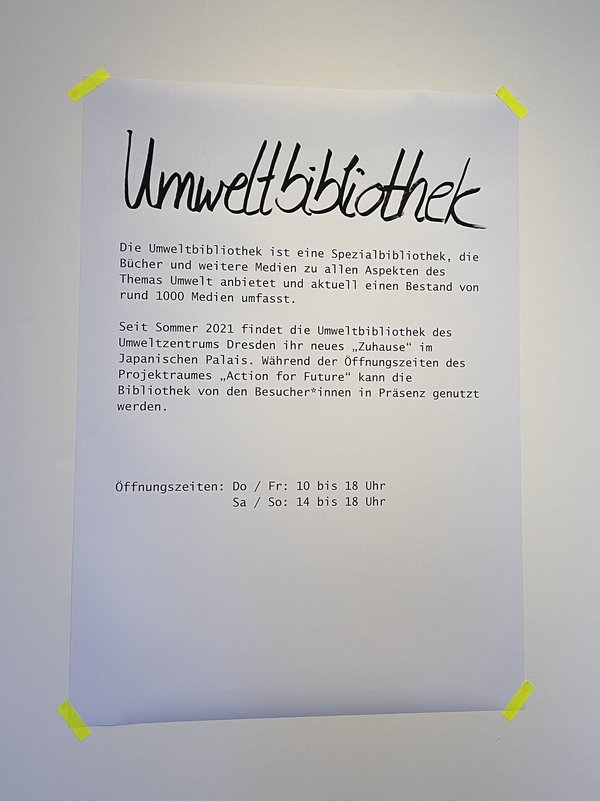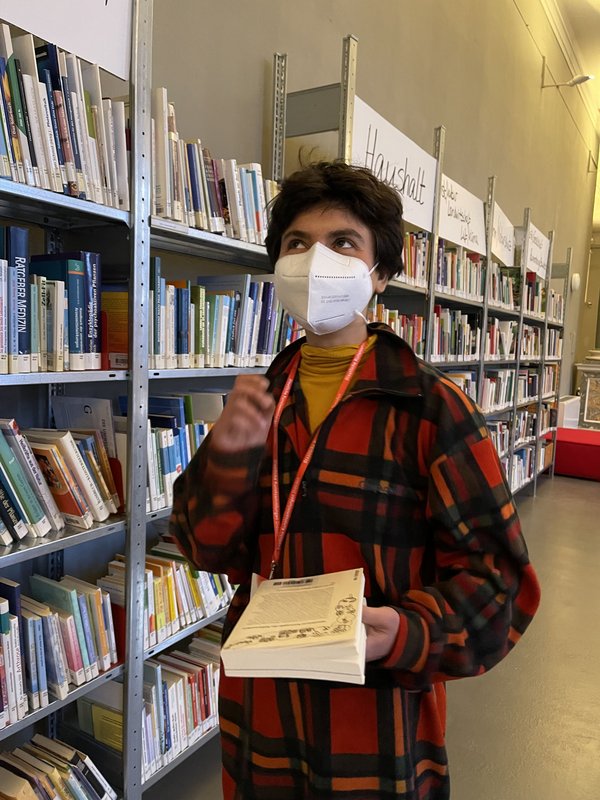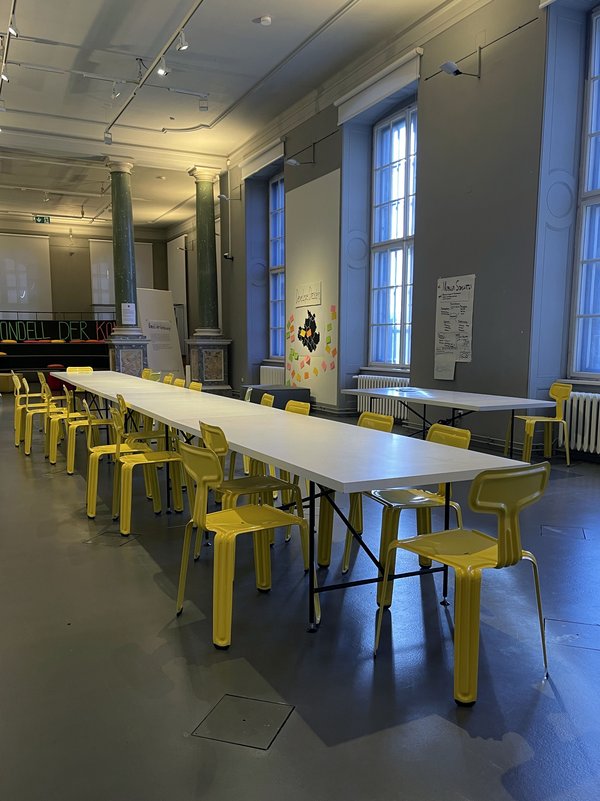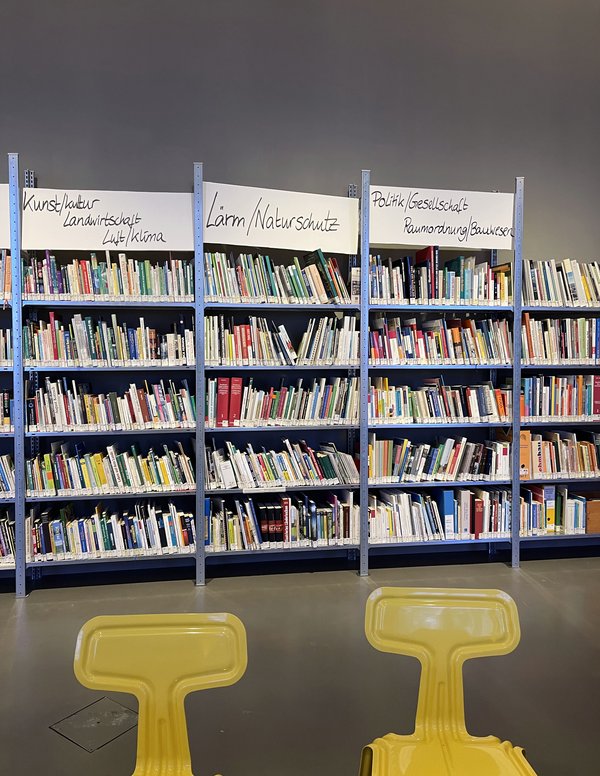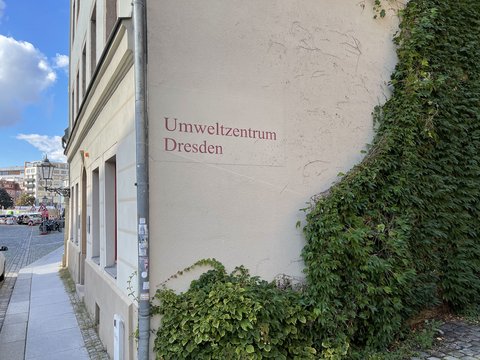
Umweltzentrum Dresden. Foto: Sebastian Mühl
Voices Mag: Dear Ms. Nikol, dear Ms. Pohle, we at the Japanisches Palais are so pleased to become custodians of the Environmental Library’s holdings, passed on from the Umweltzentrum Dresden on the occasion of the “Children's Biennale – Embracing Nature”. Up until now you were in charge of the library in its former location in the Wilsdruffer Vorstadt. Please tell us what exactly is an environmental library?
Martina Pohle: As the name tells you, an environmental library is a specialized library focused on nature and environmental protection. The core subjects that were especially covered in our holdings pertain to nature protection in the sense of species and biotope preservation, but also environmental protection in its wider sense. The collection that has now gone to the Japanisches Palais comprehends a number of main groupings, subdivided into ‘forest,’ ‘water,’ ‘energy,’ ‘traffic,’ ‘climate’ and ‘soil,’ on to ‘environmental policy’ and ‘sustainable architecture’. In addition there is a large portion with titles on environmental education for children and youth, as well as groupings targeting the private sphere of life, such as health, household and garden. There is also the so-called ‘bicycling library,’ which occupies a unique place. Originally coming from a private collector, it has numerous maps, as well as bicycle itineraries and travel guides.
Where do the library’s holdings come from originally?
The sources vary greatly. Our main partner in recent years has been the German Environment Agency, which has put copies to our disposal. Other than that we own books arriving from the Saxon State Agency for Civic Education and the Heinrich Böll Foundation, with, in addition, a small budget that was used for new purchases. Last but not least, we’ve been receiving book donations.
And since when has the library been in existence?
Claudia Nikol: In its current format, since 2011. The Umweltzentrum here at Schützengasse 16 was being renovated prior to that. This atrium we’re sitting in now, where the library was later set up, was being redone. Previously this used to be an open central courtyard, but we wanted to find another use for this place. We wanted to make a collective space out of it, for sharing information from different projects and organizations located in this building that we could compile and make available. At the time many environmental groups had a seat here, Greenpeace, the NABU (the Nature and Biodiversity Conservation Union), the Grüne Liga und the BUND (Friends of the Earth Germany), in addition to our own educational projects, which had already been ongoing at the time. The library was a place where we could bring school children for example. It was not just about having the books available to us, but also to make an offer for schools.
Martina Pohle: However, historically the origins of the library lie in the 1990s.
Claudia Nikol: Yes, that’s true. Before 2011 the library was housed on the third and fourth floors of this building; the collection however was much smaller then and divided between several archives. It was only in 2011 that everything was brought together, here in this beautiful reading area at the atrium.
But already during the GDR, other environmental libraries were being set up, is that right? Did such libraries exist in other cities, too? Is that an East German phenomenon?
Indeed so, actually you’d have to go back further in time. The origins of our own library also go back to the later years of the GDR. At the time, no official environmental reports were being issued that people could go and consult freely. And although pollution was admitted to openly, information from official sources had always been withheld –supposedly, you have no troubles under socialism. There were many people who, as employees in environmental institutes, were beginning to set up their own databases and collections, privately. And that became the basis from which the libraries would later emerge. These individuals were often active in unofficial environmental groups, too; the libraries were partly an offshoot of such organizations, the Grüne Liga being one example. At the beginning, each would simply contribute their part.
Martina Pohle: Back then, our own library was passed on to us from the Grüne Liga, I now come to remember.
Claudia Nikol: The Grüne Liga was among the co-founders of the Umweltzentrum Dresden. Officially, no environmental groups were even allowed to operate before 1989. The Grüne Lina came into being in 1990, at the same time as the Umweltzentrum. And, as you’ve said, environmental libraries do exist in other cities, too, for example inside the Ökolöwe, an environmental association in Leipzig. That’s another association that was set up in 1989, and they are active on the level of municipal and transportation policies. They have quite an extensive library over there, it’s at least twice or three times as large in terms of materials compared to what we used to have in this location.
Are there still any historical items among the library’s current holdings, or do such items get lost over time?
Martina Pohle: Yes of course, there’s the ‘bicycling library’ for example, with its GDR cycling routes and the travel guides. And a few monographs that are quite old…
Right now, the library is on display on the first floor of the Japanisches Palais, where it’s open to the public. We’ve brought in reading desks especially to that end. And once the show is over, the library is set to remain at the Japanisches Palais. What were the reasons for which you entrusted us with this library?
Claudia Nikol: Well, our aim was to have a place for information, for exchange, for imparting knowledge. But this increasingly takes place on other platforms, often digitally; in Saxony, libraries are quite advanced in terms of digitalizing. At the same time, we’ve noticed that despite all our efforts, the digital offerings have grown to such an extent that the public no longer shows up as much as it used to. For a long time we were an important spot for teachers, who could come by and pick up books reliably and on short notice, in case these were loaned out or unavailable in the municipal libraries. But over time, as things are now available online, we’re forced to ask ourselves how to react to those changes. Our environmental programs for schoolchildren for example are still ongoing, and with considerable success. Here we teach people how to find knowledge that they don’t necessarily have in mind initially. The idea of relocating the library to the Japanisches Palais came relatively late, yet it makes total sense. At this point in time, the library does belong in a museum, to some extent.
Our idea however is to have the library not just on display as a historical artifact, but also for it to be open for the public to reference…
Martina Pohle: That is obviously great, and it would be fantastic if the library could continue to grow. If a small budget were set aside for new acquisitions, maybe an ongoing subscription or two for periodicals, to keep things up-to-date. And then, step by step, to go back to collecting monographs and grey literature – publications that are issued by associations, organizations and research facilities. Personally, I was obviously heartbroken to have to see the library go, but eventually I am truly happy that our holdings were not dispersed, but kept together and passed on as a whole. And the Japanisches Palais seems the ideal venue to us, with all the discussions that are held there around sustainability. There’s even the Zero Waste Café operating at the Palais…
Claudia Nikol: I see it in quite the same way. Especially if you’re looking to orientate children towards knowledge on nature and environmental protection, it becomes clear that books are still of value, even more so when considered against smart phones and other devices. Books are more sustainable, they’re made of renewable resources, contrary to the silicon we have in our smart phones. A book is tangible, it has a smell to it – that is also a way for knowledge to manifest and embody itself. Obviously, the idea of widespread, digitally-available knowledge for all appeals to me greatly. Nowadays everything is shareable, open-source, more than ever. But a library also holds a mirror to us, where we can see how it all began. So now it’s a bit more museum-like, but at the same time more practical for children – because we don’t like our children to just sit in front of screens all day.
And how do things look like going forward at the Umweltzentrum?
Oh, we’re coming up with ideas already. The library was always a place for sharing and exchange with others, a place of togetherness. Which is why this atrium that previously housed the library is going to become a meeting spot, there’ll be coffee tables and sofas where we can all meet up and get together.
